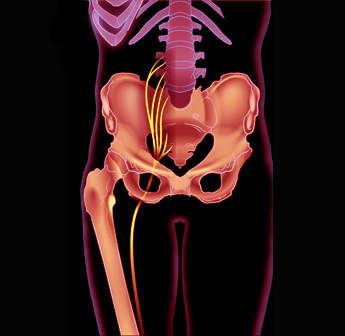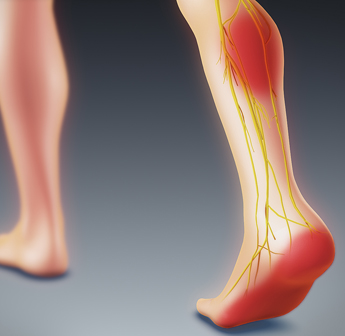Sciatica is a health condition characterized by pain from the lower back to the lower leg. This pain can go to the back, outside, or front of the leg. The onset is often followed by activities such as heavy lifting, although a gradual onset may also occur. Pain is often described as shooting. Typically, symptoms occur only on one side of the body. However, there may be pain on both sides due to some reasons. Lower back pain sometimes occurs. There may be weakness or numbness in the affected leg and various parts of the foot.

Anterior view showing the sciatic nerve going down the right leg
About 90% of sciatica is caused by a spinal herniation that is pressed on one of the lumbar or sacral nerve roots. Spondylolisthesis, spinal stenosis, piriformis syndrome, pelvic tumor and pregnancy are other possible causes of sciatica. A straight-leg lifting test is often helpful in diagnosis. The test is positive if, when the leg is raised when a person is lying on their back, the pain shoots below the knee. Medical imaging is not required in most cases. However, imaging can be achieved if bowel or bladder function is affected, there is significant loss of feeling or weakness, symptoms persist for a long time, or there is concern for tumors or infections. Similar conditions can cause hip diseases and infections such as early shingles (before the formation of rashes).
Initial treatment usually involves pain medications. Although evidence for pain medication and muscle relaxants is lacking. It is generally recommended that people proceed with normal activity according to their abilities. Sciatica is all the time required for resolution; Symptoms resolve in less than six weeks in about 90% of people. If the pain is severe and lasts for more than six weeks, surgery may be an option. While surgery often improves pain, its long-term benefits are unclear. If complications occur, surgery may be required, such as decreased normal bowel or bladder functionality. There is limited or poor evidence for their use in many treatments, including corticosteroids, gabapentin, pregabalin, acupuncture, heat or ice, and spinal manipulation.
Depending on how it is defined, less than 1% to 40% of people have sciatica at some point. It is most common in people during their 40s and 50s, and males are more affected than females. This condition has been known since ancient times. The first known use of the term sciatica since 1451.
- 1 Definition
- 2 Causes
- 2.1 Risk factors
- 2.2 Spinal disc herniation
- 2.3Spinal stenosis
- 2.4 Piriformis syndrome
- 2.5 Pregnancy
- 2.6 Other
- 3 Alternative medicine
Definition
The term “sciatica” usually describes a symptom – pain along the sciatic nerve pathway rather than a specific condition, disease, or disease. Some use it for any pain starting in the lower back and going down the leg. The pain is described as descriptive, like shooting or shock, quickly traveling along the course of the affected veins. Other terms use as a diagnosis (i.e. a cause or effect indicating a cause and effect for nerve dysfunction resulting from disc herniation from a spinal cord of the lumbar or sacral nerve roots). The pain usually occurs in the distribution of a skin and passes from the knee to the foot. It may be associated with neurological dysfunction, such as weakness and numbness.

Sciatica often results in pain radiating down the leg
Causes
Risk factors
Modifiable risk factors for sciatica include smoking, obesity and occupation. Non-modifiable risk factors include increasing age, being male, and having a personal history of low back pain.
Spinal disc herniation
Spinal disc herniation pressing on one of the lumbar or sacral nerve roots is the most frequent cause of sciatica, present in about 90% of cases. This is especially true in people under 50 years of age. Disc herniation occurs most frequently during heavy lifting. The pain is usually aggravated by bending forward or sitting, and is reduced when lying or walking. The sciatica due to the pressure of a disc herniation, and swelling of the surrounding tissue, can stop spontaneously if the disc tears and pleural exits and swelling stops.
Spinal stenosis
Other compressed spinal causes include lumbar spinal stenosis, a condition in which the spinal cord moves through the spinal space, narrowing and narrowing the spinal cord, coda equina or sciatica nerve roots. Does. This narrowing can be caused by bone spurs, spondylolisthesis, inflammation, or a herniated disc, which reduces the space available to the spinal cord, thus pinching and irritating the nerves from the spinal cord that is the sciatic nerve. Become. It is the most frequent cause after the age of 50 years. The pain caused by spinal stenosis is most often due to standing, walking or sitting and is reduced by bending forward. However, in severe cases, pain can arise with any condition or activity. Relaxing pain provides the most relief.
Piriformis syndrome
Piriformis syndrome is a condition that, based on analysis, contributes to up to 8% of low back or buttock pain from a “very rare” cause. In 17% of people, the sciatic nerve runs from the piriformis muscle instead of below it. When the piriformis is shortened or cramped due to trauma or overuse, it is believed to cause compression of the sciatic nerve. Piriformis syndrome is colloquially called “valet sciatica” because the buttock muscle and sciatic nerve are constricted in a wallet placed in the posterior hip pocket when the carrier sits down. Piriformis syndrome can be suspected as a cause of sciatica when spinal nerve roots contributing to the sciatic nerve are normal and no herniation of the spinal disc is evident.
Pregnancy
Sciatica may also occur during pregnancy, especially during later stages, as a result of the weight of the fetus pressing on the sciatic nerve during sitting or during leg spasms. While most cases do not directly harm the woman or the fetus, indirect harm may come from the numbing effect on the legs, which can cause loss of balance and falls. There is no standard treatment for pregnancy-induced sciatica.
Other
Pain that does not improve when lying down suggests a nonmechanical cause, such as cancer, inflammation, or infection. Sciatica can be caused by tumors impinging on the spinal cord or the nerve roots. Severe back pain extending to the hips and feet, loss of bladder or bowel control, or muscle weakness may result from spinal tumors or cauda equina syndrome. Trauma to the spine, such as from a car accident or hard fall onto the heel or buttocks, may also lead to sciatica. A relationship has been proposed with a latent Cutibacterium acnes infection in the intervertebral discs, but the role it plays is not yet clear.
Alternative medicine
Acupuncture has been shown to improve sciatica-related pain, though the supporting evidence is limited by small study samples. Low to moderate-quality evidence suggests that spinal manipulation is an effective treatment for acute sciatica. For chronic sciatica, the evidence supporting spinal manipulation as treatment is poor. Spinal manipulation has been found generally safe for the treatment of disc-related pain; however, case reports have found an association with cauda equina syndrome, and it is contraindicated when there are progressive neurological deficits.
Leave a Reply